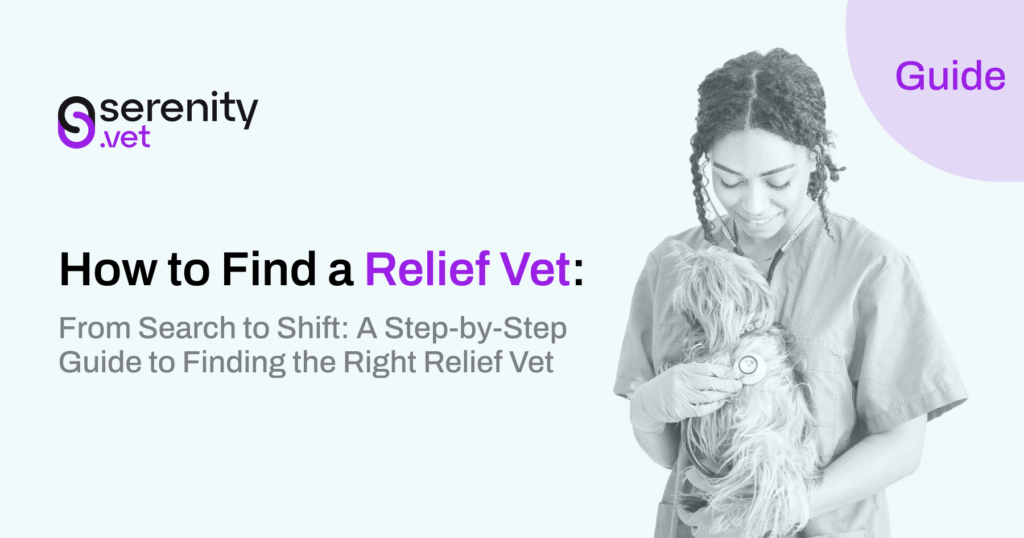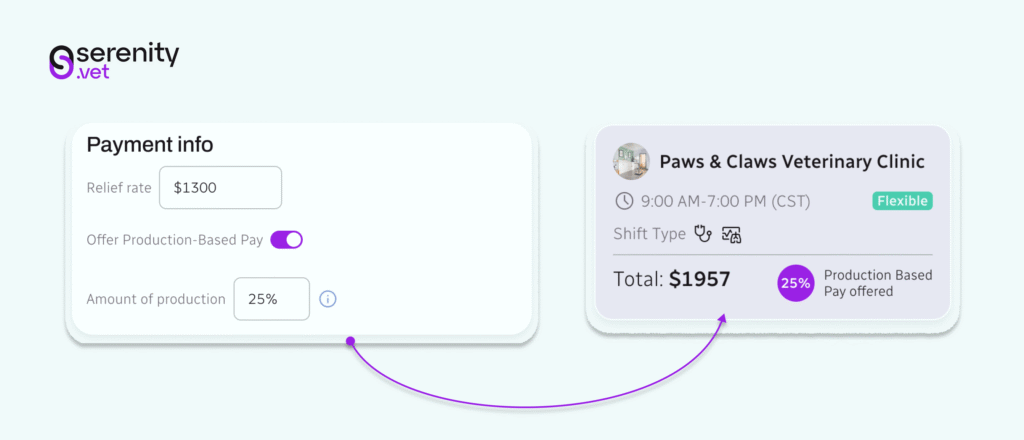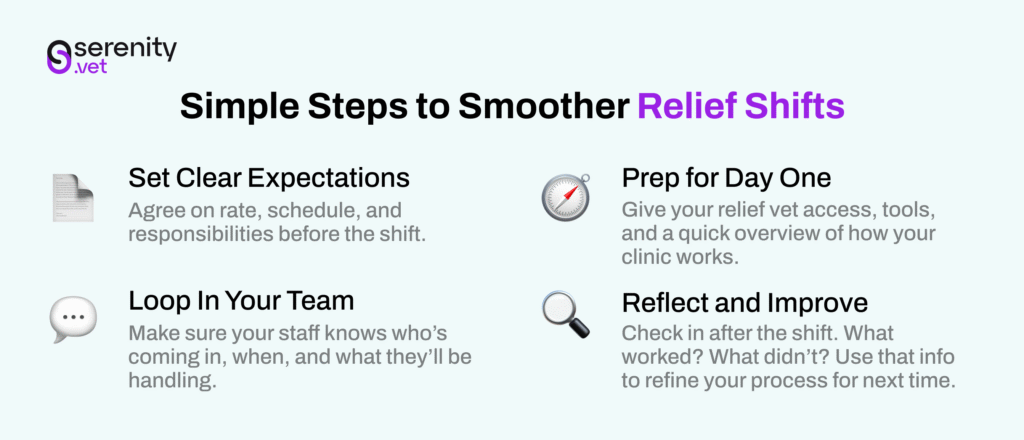
How to Find a Relief Vet: Vetting, Booking, and Getting the Right Fit
Finding a relief vet can feel deceptively simple — until you’re scrambling to cover a last-minute shift or stuck in a packed schedule, realizing the person you brought in is slowing things down instead of helping.
It doesn’t have to be that way.
A bit of planning upfront can save your team from added stress and make sure the support you bring in actually feels like support.
In this guide, we’ll break down the process into four key stages:
- Vetting (how to identify a good match),
- Booking (locking in coverage without chaos), and
- Setting the Shift Up for Success (what to do once they’re actually in your clinic).
- Post-Shift Follow-Up (how to learn from the experience and build long-term support).
When you know what to look for and how to plan ahead, bringing in relief support can be straightforward, and actually helpful. Here’s how to make it work:
Step 1: Know What (and Who) You’re Looking For
Before you post a shift or start reaching out, take a few minutes to define what you actually need.
Are you covering a few sick days? A long vacation? Do you need someone confident with surgery? Exotics? Emergencies? Or just a steady set of hands to keep things moving? Pinpointing the schedule and skill set helps filter out mismatches early.
From there, think about the kind of person who tends to work well in your clinic. Some teams rely heavily on collaboration. Others need someone who can jump in and work independently. Every veterinarian has a different style — and the more upfront you are about what yours is, the better your chances of finding a good match.
Finally, consider performance. If you’re aiming for productivity or specific case outcomes, you’ll want someone who’s used to that pace.
Clear criteria on your end lead to better matches — and better results when the shift starts.
Step 2: Vet Beyond the Resume
Once you’ve defined what you’re looking for, the next step is making sure the candidates you’re considering actually match that profile.
There are a few ways to start your search:
You can try a relief platform (like Serenity Vet), ask around in your local network, post in veterinary Facebook groups, or work with a recruiter. No matter where you’re looking, remember: experience on paper only tells part of the story.
Start with the basics: review clinical experience, licensing, and the types of cases they typically handle. If your clinic is fast-paced or sees a lot of sick patients, a vet who prefers low-volume wellness care might not be the best match, no matter how qualified they are.
A vet might have 10+ years of clinical work but still be a poor fit if they’re not comfortable with your pace, protocols, or communication style. Relief work requires adaptability — the ability to walk into a new environment and get up to speed quickly, while still delivering high-quality care and collaborating with your team. That’s not something you can always spot on a resume.
So how do you dig deeper?
Start with a quick call or message exchange that gives you more context than just availability. Look for signals of flexibility and self-awareness. Do they ask questions about your setup? Do they seem confident navigating new situations, or do they prefer a slower ramp-up? Do they sound like someone who’s worked in clinics like yours before?
Here are a few practical questions to help guide that conversation:
- How do you usually approach emergency situations in a new clinic?
- Are you familiar with our PIMS, or open to a quick walkthrough before the shift?
- What kind of clinic environment helps you do your best work?
- How do you like to receive feedback — during the shift or after?
- What makes a shift feel successful to you?
You can also ask situational questions, especially if your clinic has specific challenges. For example:
“We often have one tech assisting two vets during busy times — how do you usually adapt in that kind of setup?”
We see a fair number of exotic pets — do you have experience with small mammals or reptiles?”
Don’t be afraid to go beyond logistics and resumes. A short conversation can go a long way in helping you find someone who’s not just capable, but truly compatible with your clinic’s culture.
Find Relief Vets on Your Terms
Set the rate, pick the vet, and keep your clinic running at full speed.
Step 3: Book with Confidence
Once you’ve found the right vet, don’t wait too long to lock things in — especially if you’re scheduling during busy seasons, holidays, or around CE events. Relief veterinarians get booked fast, and a little planning goes a long way.
When you’re ready to move forward, be clear about expectations upfront. Confirm the hours, scope of work, and any special cases they should be aware of. If your clinic has specific protocols, share those ahead of time so there are no surprises.
Compensation matters too. If you’re using Serenity Vet, you have full control:
- Set your own rate based on what’s sustainable for your practice
- Offer optional production bonuses to attract vets who are performance-driven
- Only pay for completed shifts, with no hidden commitments.

Step 4: Don’t Skip the Legal Stuff
Before any relief vet walks into your clinic, make sure everything’s squared away legally. Even if you’re booking through a trusted platform, it’s still your responsibility to confirm they’re licensed and eligible to work in your province or state.
At a minimum, verify:
- An active veterinary license for your specific state or province
- Liability insurance (often required for relief vets — ask for proof)
- Right to work (for clinics near the border, make sure you’re not hiring across international lines without the proper paperwork).
In Canada, relief vets typically need to be registered with the appropriate provincial veterinary medical association. In the U.S., each state has its own licensing board — and some also require DEA registration if controlled substances are involved.
A quick check now is one of the simplest ways to protect your clinic — and end the day without surprises.
Step 5: Set the Stage for a Smooth First Shift
Even the best vet needs a little context to hit the ground running. A quick handoff can make a big difference in how the shift goes — for them, your team, and your clients.
Here’s a simple checklist to have ready:
- EMR access and quick-reference guide (logins, shortcuts, common templates)
- Walkthrough of clinic systems (PIMS, comms tools, how you chart and communicate)
- Workflow overview (who handles what, where supplies are, any need-to-know quirks)
- Expectations around medical records, client communication, and tech support
- Day 1 logistics (arrival time, dress code, parking, who they’ll be working with)
- A point person they can go to with questions during the shift.
If you’re booking through Serenity Vet, you can message directly through the platform ahead of time, so key details don’t get lost in email threads. You’ll also know exactly what rate was agreed upon, how it was calculated, and what fees apply — no awkward misunderstandings at the end of the day.
Consider putting together a short relief onboarding doc once and reusing it for every shift. It saves your staff from answering the same questions over and over and helps your relief vet feel confident from the start.
The more prepared they are, the smoother the shift will go — for everyone involved. A little upfront effort often leads to fewer questions, better flow, and less pressure on your staff.

Step 6: Make Sure It Actually Works
Once the shift is over, take a moment to reflect — not just on the relief vet, but on how everything functioned as a whole. Check in with your team while it’s fresh. Was communication clear? Did things run smoothly? Were there any moments that felt confusing or off?
From there, think about what stood out — both the positives and anything that felt off. Did the vet mesh well with your team? Were they adaptable, clear in their communication, and aligned with how your clinic handles cases? Or were there moments of friction, missed expectations, or signs that it just wasn’t the right match?
It’s not about picking someone apart — it’s about understanding what worked, what didn’t, and whether those things were specific to the individual or something you can smooth out on your end next time.
Keep in mind that not every issue is about the vet. Sometimes, it’s your workflow showing cracks. If the relief vet had the right attitude and skills but still ran into issues — like not knowing where to find supplies, or being unsure about case flow — that might point to gaps in your handoff or onboarding. In those cases, the shift can act like a mirror, revealing places where your practice could operate more clearly or consistently for any team member, not just relief support.
Relief coverage works best when it’s part of a system. A little honest reflection after each shift helps you improve that system, build trust with your team, and make stronger decisions moving forward.
Wrapping It Up: How To Make Relief Hiring Work For You
Relief coverage doesn’t have to be stressful. With the right process, it can strengthen your clinic — not just fill a gap. Here’s what to keep in mind:
- Start with a clear picture of what you need.
Know your schedule gaps, must-have skills (surgery, exotics, etc.), and what type of personality thrives in your clinic’s environment. - Go beyond the resume.
Experience matters, but so do soft skills like adaptability, autonomy, and communication. Ask smart questions to get a real sense of fit. - Plan the booking process like you would for a new hire.
Confirm expectations, scope of work, and compensation upfront. A little clarity here prevents confusion later. - Be thoughtful about compensation.
Set rates that work for your practice, consider offering production bonuses, and make sure terms are transparent and fair for both sides. - Make onboarding easy and welcoming.
A quick walkthrough, clear point of contact, and a heads-up about what to expect on Day 1 go a long way in setting up a successful shift. - Check in after the shift.
Get team feedback, note what worked (or didn’t), and keep a list of strong candidates you’d work with again. - Think long-term.
Relief coverage isn’t just a short-term patch — it’s a way to build flexibility into your operations, support your team, and maintain care standards during busy times or burnout recovery.
About Serenity Vet
Serenity Vet connects clinics with skilled relief veterinarians across the country.
With real-time availability, advanced filtering, and built-in contracts, it’s designed to take the guesswork (and inbox chaos) out of relief hiring.
👉 Ready to simplify your relief coverage?

